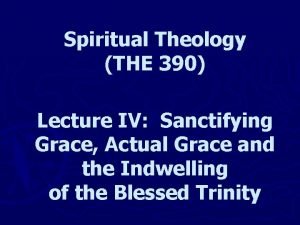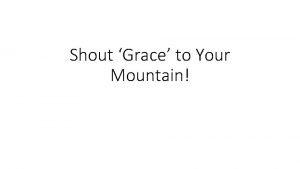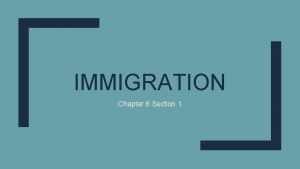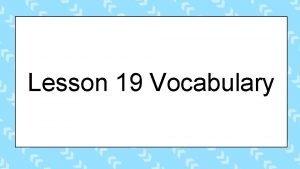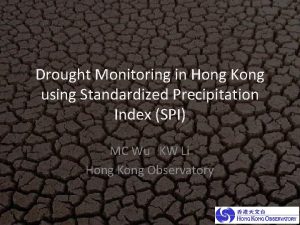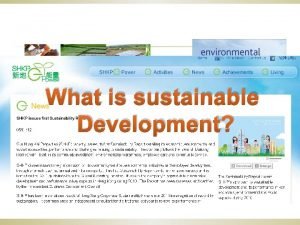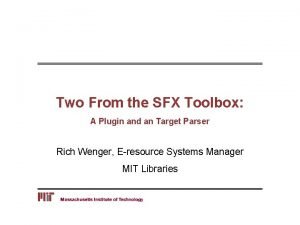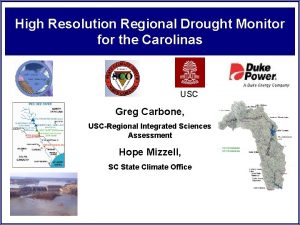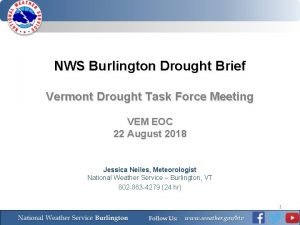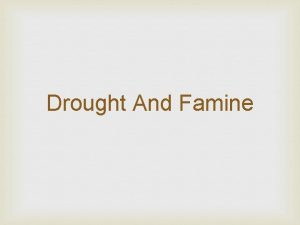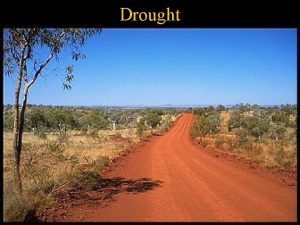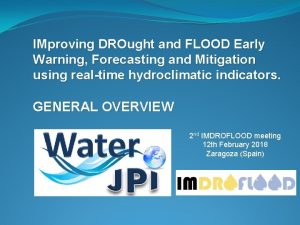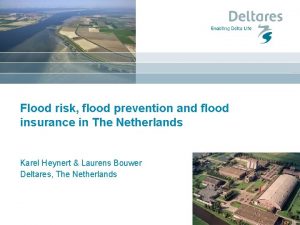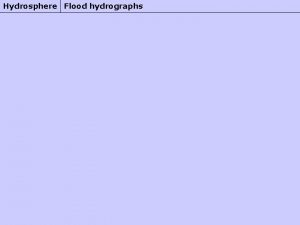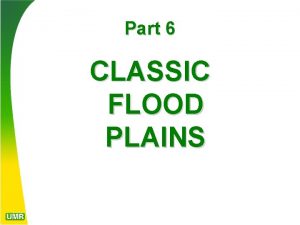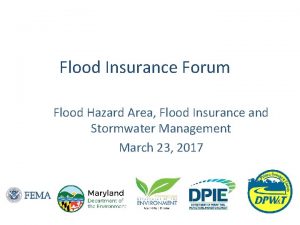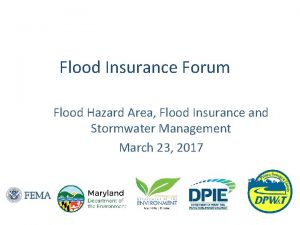Integrating GRACE into Drought Monitoring Flood Forecasting and















- Slides: 15

Integrating GRACE into Drought Monitoring, Flood Forecasting and Agricultural Markets related Decisions Richard Bernknopf, Yusuke Kuwayama, Matthew Rodell, and Benjamin Zaitchik October 30, 2019

Measuring the socioeconomic benefits of GRACE in the VALUABLES framework 1 satellite and 3 impact assessments: • Probabilistic model (ensemble product): Spatiotemporal RSDI improve the reliability of existing forecast and monitoring methods of natural hazards • Gravity and Recovery Climate Experiment (GRACE) • Valuation (quantitative method – market, nonmarket): Economic estimation of return on investment (expected benefits) to reduce societal risks • USDA Drought Monitor for disaster assistance • NOAA NWS river flow forecast for floods • Soil moisture and yield forecasts for grain markets • Empirical analysis (VALUABLES framework): Integration of the probabilistic earth science model and values at risk for impact assessment 2 Integrating GRACE into Drought Monitoring, Flood Forecasting and Agricultural Markets Related Decisions Gravity Recovery and Climate Experiment (GRACE) Source: NASA/JPL-Caltech (2013)

How does information yield benefits in INFORMATION application 1? GRACE informs the US Drought Monitor (USDM) with 3 water storage indicators to monitor weekly drought conditions. USDM is a drought severity classification of an objective blend of data (PDSI, CPC Soil Moisture, USGS daily streamflow precipitation, remotely sensed vegetation health) and expert weighting. DECISIONMAKER ACTIONS Managers implement regulations with Managers implement USDM to total water storage data for loss determine eligibility for drought disaster estimation and disaster assistance. decision. OUTCOMES FOR PEOPLE AND THE ENVIRONMENT USDM is the basis for decisions USDA drought assistance programs are associated with the application and administered with more information that allocation of drought disaster assistance reduce government costs. and insurance. 3 Integrating GRACE into Drought Monitoring, Flood Forecasting and Agricultural Markets Related Decisions

1. Integrating GRACE into the U. S. Drought Monitor (USDM) R. Bernknopf, Y. Kuwayama, D. Brookshire, M. Macauley, B. Zaitchik, A. Thompson, and P. Vail Drivers: • US Agricultural Act 2014 – Payments to eligible livestock producers due to drought (Livestock Forage Disaster Program) • USDA Farm Service Agency Emergency Designation / Declaration – Emergency loans to eligible producers suffering losses due to drought - Secretarial Disaster Designation Process 7 CFR Part 759 New Information: 4 • Ensemble of GRACE data & a catchment land surface model of water storage information as a statistical distribution of wetness (percentiles) • Production of 3 weekly drought indicators: surface soil Integrating GRACE into Drought Monitoring, Flood Forecasting and Agricultural Markets Related Decisions moisture, root zone soil moisture, and groundwater

Case study results Outcome: • Reduction in the magnitude of the prediction error farm income with the addition of GRACE to the USDM for 2002 – 2013 • Reduction of prediction error should increase the efficiency of management decisions Policy Analysis and Implication: • USDA Livestock Assistance Grant Program - State block fund to recover forage losses in 2006 drought • $50 million for eligible counties; eligibility if USDM classified county at D 3 or D 4 between 3/7 and 8/31 • How would county eligibility have been affected if more GRACE-DA information were taken into account? About $16 million of the $50 million would have been allocated to different States. 5 Integrating GRACE into Drought Monitoring, Flood Forecasting and Agricultural Markets Related Decisions

How does information yield benefits in INFORMATION application 2? NWS produces expert-based probabilistic river GRACE informs National Weather Service flow forecasts for flood protection that includes river flow models with 3 -month forecasts of a regional updating process to accommodate soil moisture and groundwater storage statistical local conditions. distributions to improve flood forecasts. DECISIONMAKER ACTIONS USACE flood hazard communications are Informs USACE hazard assessments and based on 2 new wetness indicators to warnings to stakeholders for short term improve timing of hazard flood protection, management decisions announcements. and response. OUTCOMES FOR PEOPLE AND THE A hazard announcement helps NWS and USACE programs provide ENVIRONMENT communities minimize losses. inputs to communities for more cost. Communication of information and effective short-term flood protection warnings uses predictive information to decisions. protect people and property. 6 Integrating GRACE into Drought Monitoring, Flood Forecasting and Agricultural Markets Related Decisions

2. Integrating GRACE into flood hazard communication R. Bernknopf, Y. Kuwayama, R. Gibson, M. Rodell, B. Zaitchik, R. Schueneman, M. De. Weese Drivers: • National Weather Service (NWS) Policy Directive 90 -2 September 30, 2016 Staffing and Organization NWS Mission and Organization • Department of the Army U. S. Army Corps of Engineers Risk Assessment for Flood Risk Management Studies, Engineer Regulation 1105 -2 -101, July 17, 2017, Circular No. 1110 -2 -6074, 31 January 2018, Engineering and Design Guidance for Emergency Action Plans, Incident Management and Reporting, and Inundation Maps for Dams and Levee Systems New Information: • GRACE provides a distribution of soil moisture storage to the Sacramento Soil Moisture model in the NWS Community Hydrologic Prediction System • 3 -month soil moisture wetness percentiles as a statistical distribution 7 Integrating GRACE) into Drought Monitoring, Flood Forecasting and Agricultural Markets Related Decisions Valley City, ND

GRACE 3 -month soil moisture indicator GRACE DA provides an input to the Sacramento Soil Moisture Accounting model in a flood hazard forecast (3/7/2011) 8 Integrating GRACE into Drought Monitoring, Flood Forecasting and Agricultural Markets Related Decisions

Flood exceedance probabilities without and with GRACE (03/18/2011 – 06/16/2011) Source: NWS 2018 ESP Open 03/11/2011 ESP + GRACE 03/11/ 2011 Conditional simulation (CS) line indicates chances of the river to rise above current conditions. 9 Integrating GRACE into Drought Monitoring, Flood Forecasting and Agricultural Markets Related Decisions

2011 Emergency Levee Construction Cost (Source: R. Schueneman, Field Report, Sheyenne River, Valley City in Barnes County, ND, May 2011) • Valley City mitigation had 3 phases using clay levees, sandbags, and Hesco barriers. • Implemented Phase 1, then moved into Phase 2 as conditions changed, ultimately implemented Phase 3. • NWS forecast and USACE risk information helped place protective measures for April 13 -15 high flows be 3 released. Option from Baldhill Emergency levees for Option 1 Option 2 that would Option 3 implemented risk management Dam. Event in progress by April 11 10 Protection Effectiveness Protect City to 50% event (19. 1 feet) Option 1 and if conditions warrant raise to 30% event (20. 4 -feet) Protect City to 24 -feet and construct contingency levees behind all sandbag and Hesco lines Effort 4 -5 days, 24 hrs. per day 9 -10 days, 24 -hrs per day City priorities: 1. Downtown business district 2. Valley City State University 3. Remaining areas Total cost 5 -6 days, 12 hrs. per day $1. 3 M $3. 0 M

Cost effectiveness of estimated protection cost savings from an improved hazard communication Estimate the savings with GRACE DA that Efficiency gained via better planning with could have been realized for the emergency measures Assumptions: • No change in structural damage to buildings from flood due to hazard communications • 1 event determined by USACE as high flow event in April 2011 • Option 3 update implemented: $1. 3 million at $16. 85 per cubic yard. 11 a more accurate flood crest estimate by 3/11/11 to implement option 3. Waiting to choose the option caused a scramble for supplies due to a greater severity of the flood resulting in a higher price per yard. A savings would have been $6. 11 per yard of clay placed. • Hypothetical example: • Valley City, ND property at risk = $169 M (2009) • Actual mitigation cost = $3. 0 M (2011) • Estimated mitigation cost with GRACE = $1. 3 M Integrating GRACE into Drought Monitoring, Flood Forecasting and Agricultural Markets Related • Cost savings = $1. 7 M Decisions

3. Integrating GRACE to Improve Price Forecasts for Corn to Reduce Market Risks R. Bernknopf, Y. Kuwayama, M. Rodell, and B. Zaitchik Driver: Markets such as the Chicago Board of Trade rely on weather related information to estimate the future value of the price of corn. The futures markets use data inputs to forecast the supply of corn currently and at other critical times of the crop year. Corn yield forecasts inform decisions to purchase security options by farmers and commodity market traders and by government program managers. 12 Integrating GRACE into Drought Monitoring, Flood Forecasting and Agricultural Markets Related Decisions Source: https: //www. cannontrading. com/ tools/futures-market/grains/Corn-Futures

Applying “Market-Based Methods for Monetizing Uncertainty Reduction: A Case Study” (Cooke and Golub 2019) to Corn Futures Crop yield forecasts are based, in part, on field sampling of soil moisture 13 (Place and Brown 1987) and simulations for estimating soil water budgets (Boorn and Zidek 2012) Quantification of corn production and price are based on: Local and regional agricultural production models (includes weather) Market factors – e. g. , international exchange rates, fuel prices New Information: • GRACE provides input to the soil – water transpiration rate in the production model • Integrating 3 -month wetness percentiles represented as a statistical GRACE intosoil Droughtmoisture Monitoring, Flood Forecasting and Agricultural Markets Related Decisions distribution

Summary and Lessons Learned 14 GRACE • Reduces uncertainty of water storage estimates in a variety of decisions • Adds a data input to improve estimation skill in monitoring and forecasting droughts and floods • VOI benefits are the benefits that is due to a change in the information. The net benefits to the decision maker are the result of the information being available + the actions taken (e. g. , disaster mitigation) to avoid a loss or promote a gain. • Seek out, identify and engage the decision maker. • Convince stakeholders a VOI study is not an evaluation of them or their work. Integrating GRACE into Drought Monitoring, Flood Forecasting and Agricultural Markets Related Decisions • Be mindful of agency mission and turf.

Thank you. • Learn more about VALUABLES: rff. org/valuables • Follow us on Twitter: @RFFvaluables • Email with questions: rbern@unm. edu
 Sanctifying grace vs actual grace
Sanctifying grace vs actual grace Shouts of grace
Shouts of grace Once in grace always in grace
Once in grace always in grace Integrating quotes into an essay
Integrating quotes into an essay Integrating sources into your writing
Integrating sources into your writing Drought and desertification
Drought and desertification Europeans flood into america
Europeans flood into america Drought sentence for class 1
Drought sentence for class 1 Types of drought
Types of drought Bibliography of drought in south africa
Bibliography of drought in south africa Aleph toolbox
Aleph toolbox Drought presentation
Drought presentation Anasazi drought
Anasazi drought Mrsac maharashtra gov in jalyukt
Mrsac maharashtra gov in jalyukt Vermont drought monitor
Vermont drought monitor Utah drought map
Utah drought map
